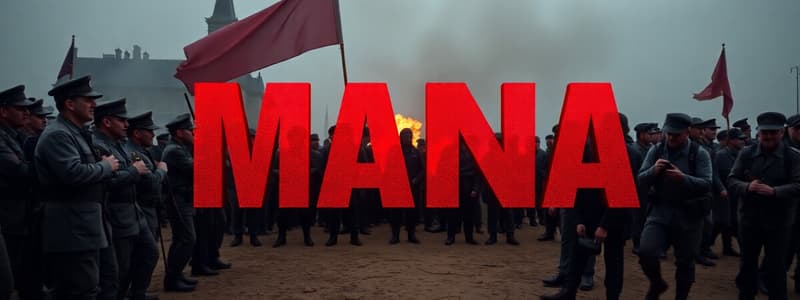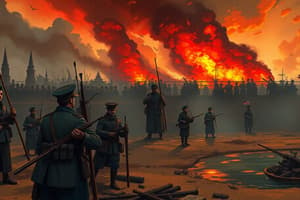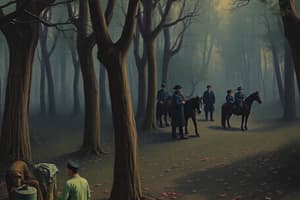Podcast
Questions and Answers
Explain how the alliance system in Europe before World War I contributed to the escalation of the conflict following the assassination of Archduke Franz Ferdinand.
Explain how the alliance system in Europe before World War I contributed to the escalation of the conflict following the assassination of Archduke Franz Ferdinand.
The alliance system created a domino effect. When Austria-Hungary declared war on Serbia, existing treaties obligated other nations to defend their allies, quickly drawing multiple countries into the conflict.
How did Serbian nationalism contribute to the outbreak of World War I?
How did Serbian nationalism contribute to the outbreak of World War I?
Serbian nationalists aimed to unify all Serbs into a single state, which led to conflict with Austria-Hungary, culminating in the assassination of Archduke Franz Ferdinand.
Describe how imperialism, specifically the competition for colonies, contributed to the tensions leading up to World War I.
Describe how imperialism, specifically the competition for colonies, contributed to the tensions leading up to World War I.
Competition for colonies led to increased tension and mistrust among European powers, as nations vied for resources, markets, and strategic advantages.
What was the Schlieffen Plan and why did it ultimately fail to achieve its objectives?
What was the Schlieffen Plan and why did it ultimately fail to achieve its objectives?
In what ways did new military technologies impact the nature of warfare during World War I, particularly on the Western Front?
In what ways did new military technologies impact the nature of warfare during World War I, particularly on the Western Front?
Analyze the significance of the First Battle of the Marne in the early stages of World War I.
Analyze the significance of the First Battle of the Marne in the early stages of World War I.
Describe the main goal of the Black Hand and how its actions affected the start of WW1.
Describe the main goal of the Black Hand and how its actions affected the start of WW1.
Explain the main ideas that are expressed in the poem In Flanders Fields.
Explain the main ideas that are expressed in the poem In Flanders Fields.
Explain how the Treaty of Versailles created instability?
Explain how the Treaty of Versailles created instability?
What was Kaiser Wilhelm II's role in rising tensions that eventually started WW1.
What was Kaiser Wilhelm II's role in rising tensions that eventually started WW1.
Contrast the goals of Georges Clemenceau and David Lloyd George in regards to the Treaty of Versailles.
Contrast the goals of Georges Clemenceau and David Lloyd George in regards to the Treaty of Versailles.
Identify a specific policy or action taken by Czar Nicholas II that negatively impacted Russia's war effort during World War I.
Identify a specific policy or action taken by Czar Nicholas II that negatively impacted Russia's war effort during World War I.
Explain why the area between opposing trenches was called 'no man’s land'?
Explain why the area between opposing trenches was called 'no man’s land'?
Briefly describe the context surrounding U.S. President Woodrow Wilson's initial declaration of American neutrality at the start of WWI.
Briefly describe the context surrounding U.S. President Woodrow Wilson's initial declaration of American neutrality at the start of WWI.
How did the assassination of Archduke Franz Ferdinand serve as the immediate catalyst for WW1?
How did the assassination of Archduke Franz Ferdinand serve as the immediate catalyst for WW1?
What were the primary goals of Franz Joseph I of Austria-Hungary in issuing the ultimatum to Serbia following the assassination of Archduke Franz Ferdinand?
What were the primary goals of Franz Joseph I of Austria-Hungary in issuing the ultimatum to Serbia following the assassination of Archduke Franz Ferdinand?
What was the main objective of the Battle of Verdun, and what broader impact did it have on the course of World War I?
What was the main objective of the Battle of Verdun, and what broader impact did it have on the course of World War I?
What role did Raymond Poincaré play in shaping France’s policy and strategy during World War I?
What role did Raymond Poincaré play in shaping France’s policy and strategy during World War I?
Describe the significance of King George V’s actions during World War I in maintaining morale and unity within the British Empire.
Describe the significance of King George V’s actions during World War I in maintaining morale and unity within the British Empire.
Aside from the assassination, what other factors contributed to Austria-Hungary's decision to declare war on Serbia?
Aside from the assassination, what other factors contributed to Austria-Hungary's decision to declare war on Serbia?
How did the use of poison gas affect Allied and Central power war strategies?
How did the use of poison gas affect Allied and Central power war strategies?
What was David Lloyd George's approach to leading the British war effort?
What was David Lloyd George's approach to leading the British war effort?
What new countries were created because of the results and conclusions of WW1?
What new countries were created because of the results and conclusions of WW1?
Give an example of how militarism increased tensions in Europe prior to World War I.
Give an example of how militarism increased tensions in Europe prior to World War I.
Which country lost the most soldiers in WW1 and which side were they on?
Which country lost the most soldiers in WW1 and which side were they on?
How did the sinking of the Lusitania influence American public opinion regarding involvement in World War I?
How did the sinking of the Lusitania influence American public opinion regarding involvement in World War I?
How did Gavrilo Princip's affiliation with the Black Hand influence the scale of WW1?
How did Gavrilo Princip's affiliation with the Black Hand influence the scale of WW1?
What was Georges Clemenceau's primary goal at the Treaty of Versailles, and how did it differ from Woodrow Wilson's?
What was Georges Clemenceau's primary goal at the Treaty of Versailles, and how did it differ from Woodrow Wilson's?
Describe the strategic importance of the Battle of Passchendaele (Ypres) and its impact on the Allied forces.
Describe the strategic importance of the Battle of Passchendaele (Ypres) and its impact on the Allied forces.
What characteristics defined trench warfare in World War I?
What characteristics defined trench warfare in World War I?
Flashcards
Militarism (WW1 Cause)
Militarism (WW1 Cause)
The build-up of armed forces and glorification of military power, creating tension among European countries before WWI.
Assassination (WW1 Cause)
Assassination (WW1 Cause)
The assassination of Archduke Franz Ferdinand by Serbian nationalist Gavrilo Princip, triggering Austria-Hungary's declaration of war on Serbia.
Nationalism (WW1 Cause)
Nationalism (WW1 Cause)
Desire for national unification and independence, fueled by the decline of empires (Ottoman).
Imperialism (WW1 Cause)
Imperialism (WW1 Cause)
Signup and view all the flashcards
Alliances (WW1 Cause)
Alliances (WW1 Cause)
Signup and view all the flashcards
WW1 Death Toll
WW1 Death Toll
Signup and view all the flashcards
Countries with Highest Casualties
Countries with Highest Casualties
Signup and view all the flashcards
Archduke Franz Ferdinand
Archduke Franz Ferdinand
Signup and view all the flashcards
Gavrilo Princip
Gavrilo Princip
Signup and view all the flashcards
The Black Hand (Serbia)
The Black Hand (Serbia)
Signup and view all the flashcards
Czar Nicholas II
Czar Nicholas II
Signup and view all the flashcards
Woodrow Wilson
Woodrow Wilson
Signup and view all the flashcards
Kaiser Wilhelm II
Kaiser Wilhelm II
Signup and view all the flashcards
Franz Joseph I
Franz Joseph I
Signup and view all the flashcards
Georges Clemenceau
Georges Clemenceau
Signup and view all the flashcards
Raymond Poincaré
Raymond Poincaré
Signup and view all the flashcards
King George V
King George V
Signup and view all the flashcards
David Lloyd George
David Lloyd George
Signup and view all the flashcards
Trench Warfare
Trench Warfare
Signup and view all the flashcards
No Man's Land
No Man's Land
Signup and view all the flashcards
Allies and Central Powers
Allies and Central Powers
Signup and view all the flashcards
Schlieffen Plan
Schlieffen Plan
Signup and view all the flashcards
Battle of Verdun
Battle of Verdun
Signup and view all the flashcards
First Battle of the Marne
First Battle of the Marne
Signup and view all the flashcards
Battle of the Somme
Battle of the Somme
Signup and view all the flashcards
Battle of Passchendaele
Battle of Passchendaele
Signup and view all the flashcards
Treaty of Versailles
Treaty of Versailles
Signup and view all the flashcards
New War Weapons (WW1)
New War Weapons (WW1)
Signup and view all the flashcards
Study Notes
- M-A-N-I-A is an acronym to remember the 5 causes of WWI: militarism, assassination, nationalism, imperialism, alliances.
Militarism
- European powers engaged in an arms race during the 19th and 20th centuries, leading to tension.
- Great Britain and Germany were the most responsible for militarism.
Assassination
- The assassination of Archduke Franz Ferdinand triggered WWI.
- Gavrilo Princip, a Serbian nationalist and member of the Black Hand, assassinated the Archduke.
- Austria-Hungary blamed Serbia and issued an ultimatum, leading to war.
Nationalism
- Serbian nationalism was fueled by the decline of the Ottoman Empire and the desire to unite all Serbs.
- Serbian nationalists aimed to control Bosnia and Herzegovina, contributing to the assassination of Archduke Franz Ferdinand.
Imperialism
- Imperialism increased tension among European countries as nations like Britain and France expanded empires.
- Serbia felt mistreated by Austria-Hungary due to imperialistic tensions.
Alliances
- The alliance system drew more countries into the war after Austria-Hungary declared war on Serbia.
- Countries felt threatened and compelled to join alliances.
Number of Deaths and Casualties
- The total number of military deaths ranged from 9 to 11 million, and civilian deaths ranged from 6 to 13 million.
- The Triple Entente/Allies lost approximately 6 million soldiers, while the Central Powers lost about 4 million.
- Germany suffered the most deaths on the Central Powers side, and Russia lost the most on the Allied Powers side.
Archduke Franz Ferdinand
- Archduke Franz Ferdinand was heir to the Austro-Hungarian throne.
- His assassination in Serbia triggered World War I.
Gavrilo Princip
- Gavrilo Princip was a Bosnian Serb student linked to the Serbian nationalist group, the Black Hand.
- Princip assassinated Archduke Franz Ferdinand and his wife, sparking WWI.
Black Hand (Serbia)
- The Black Hand was a Serbian nationalist group formed in 1911.
- They aimed to liberate Serbs under Austro-Hungarian rule and create a unified Serbian state.
- The group's ideals led to the assassination of Archduke Franz Ferdinand.
Czar Nicholas II
- Nicholas II was the last Emperor of Russia, King of Congress Poland, and Grand Duke of Finland.
- His army was disorganized and performed poorly during World War I, leading to blame for casualties.
- His reign marked the end of the Romanov dynasty and the Russian Empire.
- He and his family were executed by the Bolsheviks.
Woodrow Wilson
- Woodrow Wilson was the U.S. President during World War 1.
- Wilson initially declared American neutrality but later led the U.S. into the war after the sinking of the Lusitania.
- He was viewed as a decisive wartime leader.
Kaiser Wilhelm II
- Kaiser Wilhelm II was the last German Emperor and King of Prussia until 1918.
- His reign saw Germany become a major economic and military power.
- His policies and promotion of militarism contributed to the outbreak of World War I.
Franz Joseph I
- Franz Joseph I was Emperor of Austria, King of Hungary until 1916.
- His ultimatum to Serbia after Archduke Franz Ferdinand’s assassination triggered Austria-Hungary's entry into World War I.
- His declaration of war on Serbia initiated the alliance system.
Georges Clemenceau
- Georges Clemenceau was a French statesman and Prime Minister who played a central role in the Third Republic.
- He played a major role in shaping the Treaty of Versailles.
Raymond Poincaré
- Raymond Poincaré was a French statesman who served as President and Prime Minister of France.
- He worked to strengthen ties with Great Britain and Russia before the war.
- He advocated for harsh terms on Germany in the Treaty of Versailles, including reparations.
King George V
- George V was King of the United Kingdom and Emperor of India from 1910 until 1936.
- He served as a figurehead for the British Empire during WWI.
- He visited front lines, fostered unity, met Allied heads of state, inspected troops, and visited the wounded.
David Lloyd George
- David Lloyd George was Prime Minister of the United Kingdom until 1922.
- During WWI he focused on increasing munitions production, implemented the convoy system, and established rationing.
- He believed in a middle ground to meet with the Germans during the peace treaty negotiations.
Trench Warfare
- Trench warfare involved opposing sides attacking, counterattacking, and defending from trenches dug in the ground.
- Trenches provided protection but also created difficult warfare conditions.
No Man's Land
- No Man's Land was the dangerous area between opposing trenches, characterized by shell holes and barbed wire.
- Crossing it was extremely dangerous due to exposure to enemy fire.
Allies and Central Powers
- Major Allied powers included the United Kingdom, France, Russia, and the U.S.
- Main members of the Central Powers included the German Empire, Austria-Hungary, the Ottoman Empire, and Bulgaria.
Schlieffen Plan
- The Schlieffen Plan was Germany’s military strategy to quickly defeat France by invading Belgium, then turn to fight Russia.
- The plan failed because Belgium resisted, Britain defended Belgium, and Russia mobilized faster than expected.
- Germany reducing the military size for the plan likely contributed to it failing.
In Flanders Field Poem
- The poem likely describes WWI fighting through a soldier's perspective, inspired by violence and glimpses of peace.
- The author was a WWI fighter.
- The poem reflects how the land was filled with graves of lost soldiers.
Key Battles
- Verdun, Marne, Somme, Passchendaele (Ypres)
Verdun
- The Battle of Verdun was the longest WWI battle, resulting in immense casualties and a stalemate between French and German armies.
Marne
- The First Battle of the Marne was a crucial Allied victory that halted the German advance on Paris.
- It prevented a potential quick German victory and led to trench warfare.
Somme
- The Battle of the Somme was a major battle on the Western Front.
- British and French forces launched a large-scale offensive against German positions, resulting in huge casualties and limited territorial gains.
Passchendaele-Ypres
- The Battle of Passchendaele was a costly campaign fought in the Ypres salient of Belgium.
- The Allies struggled to gain ground against the Germans, resulting in massive casualties and little strategic gain.
WWI Results and Conclusions
- The Treaty of Versailles in 1919 imposed harsh terms on Germany, fueling resentment and instability and aided the rise of WWII.
- The League of Nations was established.
- Empires fell, and new nations were created.
- Germany was blamed for the war and lost territory and colonies.
- Germany had to pay reparations, and its army was severely reduced.
New War Weapons
- U-boat
- Tank
- Airplane
- Grenades
- Flamethrower
- Poison gas(mustard gas)
- Artillery guns
- Machine gun
Studying That Suits You
Use AI to generate personalized quizzes and flashcards to suit your learning preferences.




